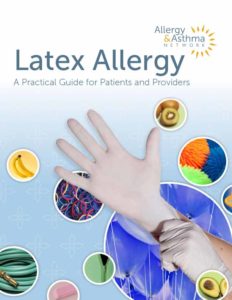Latex Allergy Facts
- Home
- |
- A Complete Guide to Allergies
- |
- Complete Guide to Latex Allergy
- |
- Latex Allergy Facts

Where does natural rubber latex come from?
- Natural rubber latex is a milky liquid produced by laticiferous (latex-producing) plants or trees.
- There are more than 2,000 laticiferous plants in the world.
- The major source for natural rubber latex is from the Hevea Brasiliensis tree. It is used to make many commercial and medical products.
Why is natural rubber latex useful?
The structure of natural rubber latex creates a strong, elastic barrier. This barrier tends to nearly be impermeable to water. Natural rubber latex returns to its original shape after applying stress force.
How is natural rubber latex made?
- Natural rubber latex is manufactured in two ways:
- the vulcanization method (a chemical treatment to harden rubber)
- the dipping method
- Approximately 12% of latex is harvested and used to make products by the dipping method.
What types of allergic reactions are caused by natural rubber latex?
Latex can result in three different types of reactions:
- IgE-mediated allergic reactions
- allergic contact dermatitis
- irritant dermatitis

Download Our Free Latex Allergy Guide ➨
A practical guide for patients and providers
What are IgE-mediated allergic reactions to latex?
- Proteins in latex are what cause immediate allergic reactions. Immediate reactions are also known as IgE-mediated allergic reactions. There are 13 different proteins in latex that are known to result in allergic reactions.
- Most allergic reactions to latex are from finished rubber products made by the dipping method. Examples include latex gloves and balloons.
What is contact dermatitis due to latex?
- Contact dermatitis is a delayed allergic reaction caused by chemical additives found in latex products.
- Some people who develop an IgE-mediated latex allergy also have prior or current contact dermatitis to latex.
Download:
Latex Allergy Fact Sheet
What is irritant dermatitis due to latex?
- Many workers who use latex gloves may get irritant dermatitis on their hands. This may be caused by sweating, cornstarch powder inside the gloves, and frequent hand washing.
- Irritant dermatitis may occur before a person develops a latex allergy. A person can also have both irritant dermatitis and a latex allergy at the same time.
What are common symptoms of IgE-mediated allergy to latex?
Latex allergy may cause:
- hives
- angioedema
- rhinitis
- conjunctivitis
- asthma
- anaphylaxis
Download Our Free “Latex Allergy Patient Checklist“
How do doctors test for latex allergy?
- Doctors typically use a blood test to test for latex allergy. Up to 8.2% of people in the United States may get a positive blood test for the presence of latex IgE antibodies.
A positive blood test for latex IgE does not always mean that a person has a latex allergy, however. Latex allergy blood tests can result in false positives in a significant number of people tested for latex. It is estimated that 10% to 25% of people tested may get a false negative result.
- Skin testing is not used for the diagnosis of latex allergy. It has not been approved by the U.S. Food and Drug Administration. Non-standard latex reagents used in skin testing can sometimes result in severe allergic reactions.

How is latex allergy diagnosed?
- The diagnosis of an IgE-mediated latex allergy is made by a healthcare professional using:
- the patient’s medical history
- a physical exam
- results of a blood test
- The diagnosis of allergic contact dermatitis is made by a healthcare professional using:
- the patient’s medical history
- a physical exam
- skin testing.
- Skin testing helps to find the chemical causing the reaction
- The diagnosis of irritant dermatitis is made by a healthcare professional using:
- the patient’s medical history
- a physical exam
- What medical conditions put you at risk for developing a latex allergy?
People at risk for developing a latex allergy are those with:
- spina bifida
- cloacal anomalies
- multiple surgeries
- diabetes
- atopic conditions
- workers in jobs where latex gloves are worn

Quick 3-5 minute videos on asthma, allergies, and related conditions.
5 Key Questions about Latex Allergy
IS LATEX ALLERGY STILL AN ISSUE?
Yes. Approximately 1% - 6% of the general U.S. population has a latex allergy.
HOW MANY PRODUCTS CONTAIN NATURAL RUBBER LATEX?
There are over 40,000 products in our environment — including many household items - that may contain latex.
WHAT ARE THE MOST COMMON ITEMS THAT MAY CAUSE A LATEX ALLERGY REACTION?
Elastic bands, latex gloves, balloons, rubber bands, vial stoppers, bandage adhesives, red rubber catheter, dental damns, condoms.
IS LATEX ALLERGY RELATED TO FOOD ALLERGY?
30 - 50% of people who are allergy to natural rubber latex are hypersensitive to certain plant-derived foods, including some fresh fruit. This is "latex-fruit syndrome".
WHAT FOODS AND PLANTS CROSS REACT WITH NATURAL RUBBER LATEX?
Banana, avocado, kiwi, potato, tomato, bell peppers, chestnut, poinsettia, figs.
How does powder in gloves trigger a latex-allergic reaction?
Certain gloves use cornstarch powder as a lubricant. The allergenic proteins in latex may carry through the cornstarch. Patients who breathe in powder containing the latex proteins may develop respiratory symptoms.

What is latex-fruit syndrome?
- Approximately 50% of people with latex allergy develop symptoms after consuming fruits that have similar proteins as latex-producing plants. This is called cross reactivity.
- Fruits that most commonly trigger reactions in people with latex allergy are:
- banana
- avocado
- kiwi
- chestnut
- Approximately 10% of fruit-allergic individuals may have cross-reactivity to natural rubber latex.
What caused the latex allergy epidemic in the 1990s?
We are still not clear about what caused the latex allergy epidemic in the 1990s. Studies suggest that the latex allergen in gloves was a factor. Powder on latex gloves may have also caused the increased number of individuals developing a latex allergy.
Source: “Facts on Latex Allergy” by Kevin J. Kelly, MD, board-certified allergist in Chapel Hill, North Carolina
Visit Our Support Pages on Latex Allergies
Latex Allergy Items in Online Store
Latex Allergy News
Latex Allergies and Vaccines
Latex Allergy Posters
& Infographics

